We’ll assume you already have the survival knife and basic Ten Essentials, and are assembling the rest of the tools needed for a portable survival kit. Do you need to add a hatchet or a small saw?
by Leon Pantenburg
It depends. Some might call this collection a “Bug Out Bag,” or something along those lines. Or you may be a backpacker, hunter or fisherman who needs a light, easy-to-carry wood cutting device. A hunter may be looking for a tool that can cut wood and that will also be useful in quartering and field dressing a big game animal. Choice of tools is important, because there isn’t much space, and you need to keep the weight down.
So, is the best choice a hatchet or a saw?
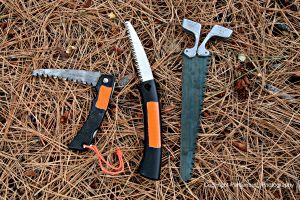
These lightweight saws are inexpensive and will handle most wilderness sawing tasks.
Either choice has advantages and disadvantages. When choosing any tool for wilderness or urban survival, start by anticipating where you might be when you may need the tool, and what tasks it will need to perform.
Will you be in a cold wilderness environment, where gathering firewood to keep a campfire going will be critical for survival? Will the tool be mostly carried, or do you anticipate remaining somewhat sedentary and that the tool may be used a great deal? Will you need to saw or hack bones to butcher large animals?
Or will the tool be used in an urban setting, where the primary uses might include breaking up pallets and splitting wood scraps from a dumpster for firewood? In an extreme situation, might you need this tool to break down a door, gain forced entry into or egress from, a locked vehicle? In a really extreme situation could this tool be an effective weapon?
Hatchet
A hatchet is a small axe that can be wielded with one hand, and the flat part may be used as a hammer. A hatchet is a great tool for splitting wood, limbing trees and hammering in tent stakes.
Many settlers on the American frontier had an axe as their primary tool. The axe may have been the only tool available for making a log cabin, splitting rails for a fence and cutting firewood. Essentially, the axe only had two parts: the head and the haft, or handle. If the handle broke, it was possible to whittle another out of a piece of hickory or some other hardwood.
A hatchet can also be sharpened easily with a flat rock. This meant, that for long-term survival, the hatchet could be a tool with incredible durability.
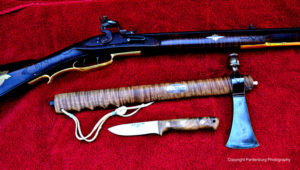
The Grenfell pipe tomahawk and handmade knife compliment my flintlock very well!
And there’s no question that an axe or hatchet makes a formidable weapon! From the stone age flint war axe, to Viking battle axes, to the tomahawks used on the North American frontier, these edged tools have been the weapon of choice in many eras.
My buddy, the late Jim Grenfell, was fascinated with ancient weapons. When he heard I hunt with a flintlock .40 caliber Pennsylvania rifle, he claimed I only had part of the kit. The tradition, Jim said, was that after finishing making a rifle, the gunsmith would take the leftover chunk of wood from the rifle stock blank, and a piece of gun barrel, and fashion a matching tomahawk. No long hunter, he pointed out, would be caught dead without his tomahawk, because if the rifle didn’t fire, the hawk was his backup!
So Jim made me a pipe tomahawk that matched my rifle. I still carry the tomahawk, along with the powder horn, shot bag and other accouterments when I blackpowder hunt. The tomahawk could be used to help quarter a deer, or field dress small game.
But I take it along because the hawk looks so cool tucked in the back of my sash next to the powder horn! When I take a break in the field, it’s fun to stick the tomahawk in a tree, lean the long rifle up against it, and hang the powder horn and shot bag off the rifle barrel. Then, I sit and admire the workmanship of my tools while chewing on jerky and hardtack.
Despite my enjoyment of tomahawks and history-related weapons, I usually carry a saw in my daypack. As a big game hunter, I need a tool that can saw through the pelvis of a deer, hog, antelope or elk. Sometimes you need a saw to cut through the ribcage of a big elk. And while I can disjoint the lower legs of an elk or deer with a good hunting knife, the saw is quicker.
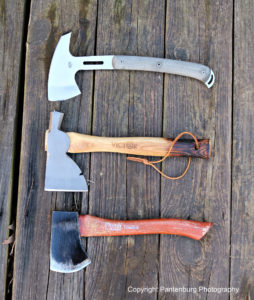
These three hatchets are suited for three different uses.
If you’re saving horns, a saw is almost mandatory. I haven’t seen anyone chop the antlers off anything, but I did loan my Pac-Saw to a guide once so he could take the antlers off a moose skull.
Many field dressing chores could probably be done with a hatchet. I used a full-sized axe once to help dress out a whitetail buck once, and it worked fine.
But there are a few safety issues associated with axes. The Boy Scouts have banned hatchets at campouts because of the potential danger. A special axe yard is cordoned off at scout camps, so nobody inadvertently walks behind an axe user. And consider that the cutting power of a hatchet or axe depends on velocity generated by swinging the tool. Axes and hatchets can bounce, slide or ricochet off wood at odd angles and then an accident is possible.
Wilderness survival expert Peter Kummerfeldt is a proponent of carrying a saw instead of an axe. He carries an 17-inch, double edged saw made by Dandy, and calls hatchets “weapons.”
“You can give your saw to someone to gather wood, and they probably won’t hurt themselves,” he said in an interview. “But with a hatchet, an inexperienced user could severely injure himself.”
I have several folding saws I regularly use, and generally have a couple along. My Swiss Army knife has a very useable, small saw blade, and so does my Leatherman Wave. Both saw blades work well for sawing through a deer pelvis bone, removing lower legs for quartering and either blade will easily saw through a stick the size of my wrist.
I’ve also carried a Gerber folding saw for about 25 years. Designed as a wood saw, it cuts as you pull. It weighs next to nothing, and is a superb limbing tool. For hunting, I carry a double-edged, single piece Pac-Saw with both wood and bone teeth. I also used a Sawsall, a fold-up woodsaw, in the Boundary Waters, and it is an effective tool.
As I see it, the primary reason for including a hatchet and/or saw in your survival kit is to gather firewood. It takes an incredible amount of firewood to keep a campfire burning throughout the night, and the person with a survival mindset will start gathering wood as soon as possible. In a pinch, it is safe and effective to pass out your saws and have everyone start gathering wood.
So which tool do you want to include in your gear? As usual, it will depend on your skill level, potential needs, and willingness to practice. You’ve already shown your survival mindset by reading this far, and now you can make an intelligent choice!
#hatchet #saw
Please click here to check out and subscribe to the SurvivalCommonSense.com YouTube channel, and here to subscribe to our email update – thanks!
Please subscribe to the Survival Common Sense website
And the Youtube channel
You can also order my book “Bushcraft Basics: A Common Sense Wilderness Survival Handbook” at your local independent book store:
or on Amazon
or at Barnes and Noble
or at Books a Million
Thanks!


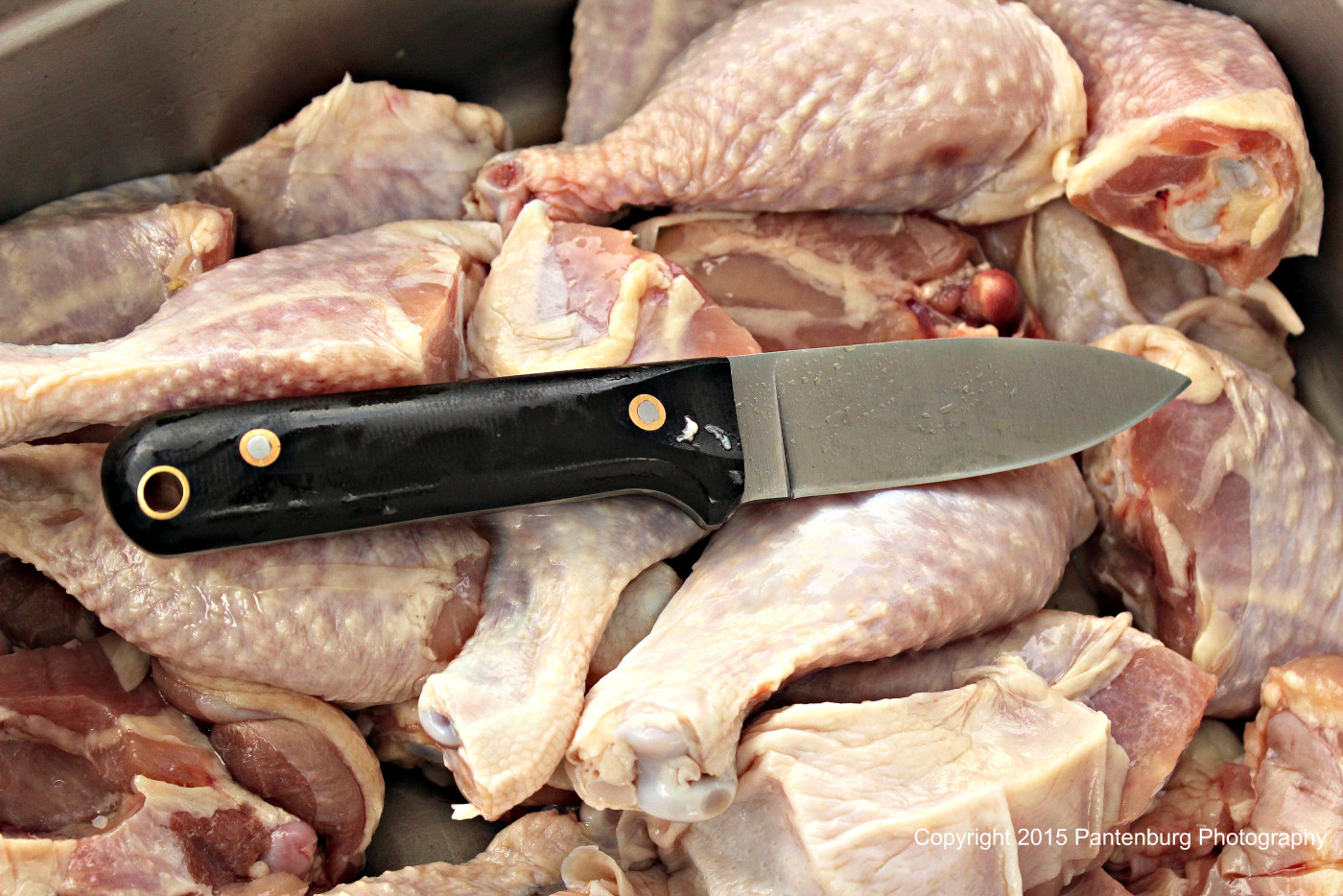

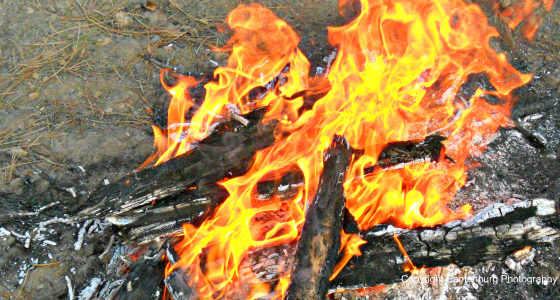
Leave a Reply